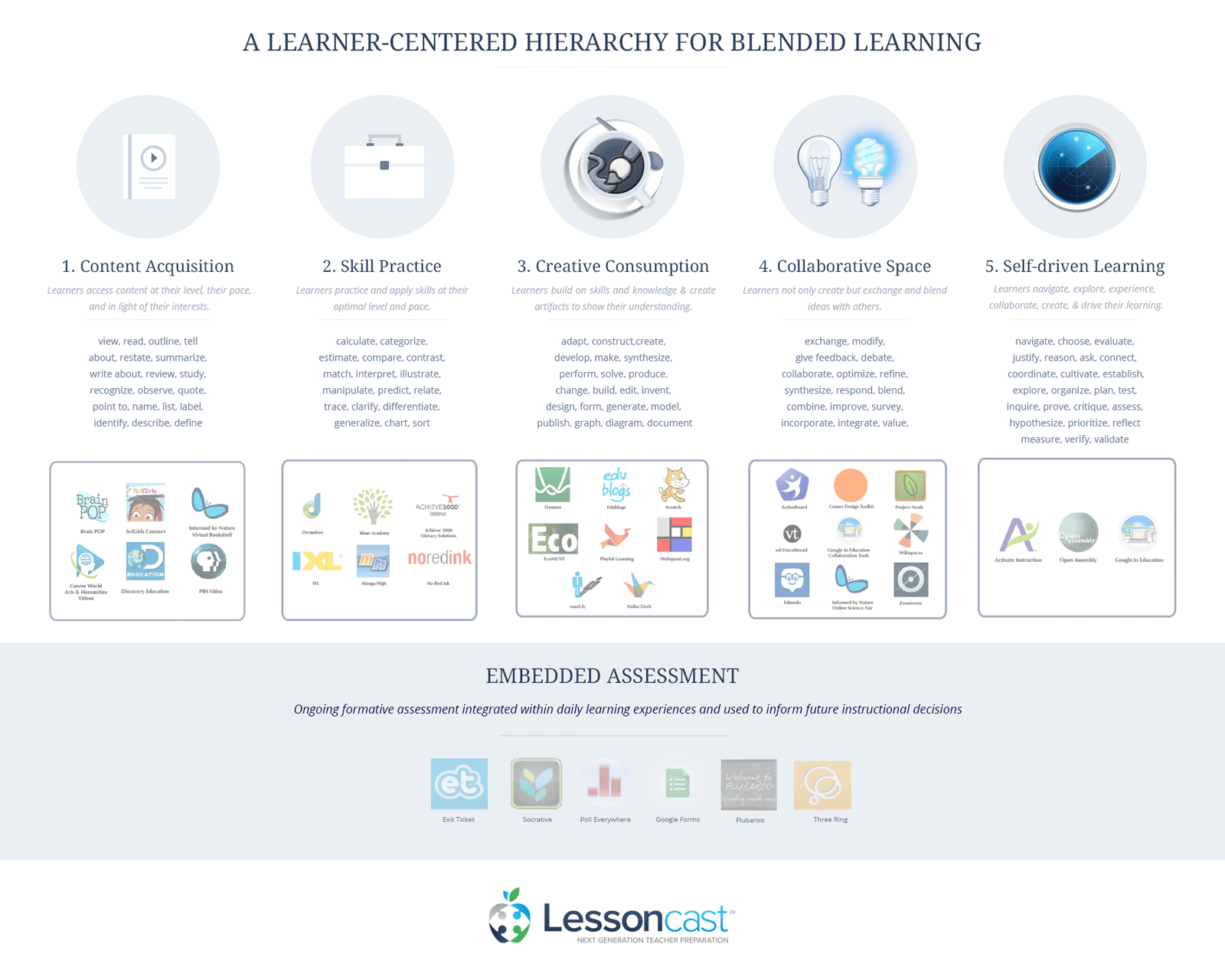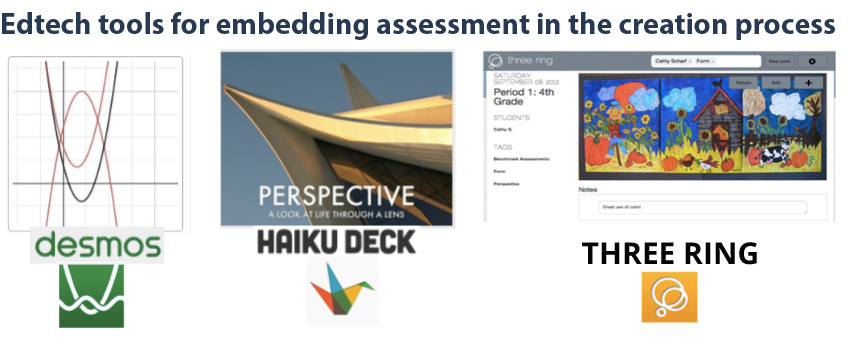
Embedded assessment undergirds each of the five levels of blended learning (as illustrated below). “Embedded” means that the assessment is part of the learning experience, not a separate activity. In this age of accountability, there is an imminent danger of over-assessment, spending so much time on testing that we’re compromising time for learning. Embedded assessment gauges student understanding while they are engaged in instruction, providing an ongoing barometer to answer the question: Are students truly learning?

(In a previous entry, we laid out this learner-centered approach for planning blended learning experiences. View lessoncast, Blended Learning and the Learner, for more details.)
Embedded assessment is not a new idea. The most effective teachers know which students are moving forward and which students need help. They can feel the pulse of student understanding and make adjustments accordingly. Without technology, teachers can embed assessment by using student response strategies as ongoing measures for knowing what students know. But what more is possible with technology?
Blended learning capitalizes on new tools to assess and gather data while students are engaged in the learning experience. Thoughtfully crafted embedded assessment supported with technology can provide a fresh perspective on whether or not learners are truly growing.
The process for embedding assessment into blended learning activities can be guided with the following questions:
- What are the desired outcomes for student learning?
- What evidence can show that students have achieved the desired outcomes?
- What tools can help gather and display evidence?
- How will the students receive useful feedback?
- How can the assessment process be embedded in the learning activity?

In thinking about the desired outcomes for student learning, consider the levels of understanding. Do students need to:
- Simply recall key ideas and details?
- Interpret information?
- Apply understanding?
- Consider multiple perspectives?
- Transfer learning to new situations?
![]()
Then the level of desired outcomes impacts the type of evidence that will demonstrate achievement. What type of task will provide relevant evidence? A comprehension question, skill practice problems, constructed responses, or a performance task?
![]()
After defining the desired outcomes and the types of tasks to show evidence, THEN consider the available tools that can help to gather and display that evidence.
Some content acquisition technology resources come with built-in assessment options. For example in this math lesson using Discovery Education video clips, the teacher can assign comprehension questions to students, and they can receive immediate feedback. This online quiz format works well with comprehension questions, selected response or constructed response items like:
- Define length.
- How many inches are in a yard?
- What would be the best tool to measure the length of the playground?
If the teacher created her own questions, she could also have a ruler and several objects or a handout with shapes near the computer.
Skill practice technology resources often embed assessment items as well. In a math lesson, students practicing factoring using IXL receive immediate feedback, and the teacher can access reports on student performance. When reviewing the data reports, consider:
- What are the trends in student performance?
- What patterns in student thinking are evident?
- What are the next best steps for instruction?
If you are used to using a pen and paper exit ticket, a few online solutions may help. Exit Ticket, Socrative, Poll Everywhere, and Flubaroo provide alternate options that allow students to respond through any web-enabled device. And don’t feel limited by the term “exit ticket.” These tools can be used as entry tickets, periodic check points, and rest stops. As a reading teacher, I would remind students to periodically pause, reflect, and check their comprehension. These tools provide a window into each student’s reflection on understanding.
If authentic assessment of a learning goal requires the creation of a product or a performance task, consider how you will capture and assess student work. Whether the assessment task is a graphing challenge on Desmos or a presentation on Haiku Deck, develop a rubric that specifies indicators of quality work. Explore having students give peer feedback as part of the learning process. Consider using a portfolio tool – like Three Ring – to capture and showcase student work.

In collaborative space blended learning experiences, students benefit from not only receiving feedback about their collaborative product but also receiving feedback about their contributions as a team member and ability to work with others. Commonly cited as a key look-for among employers, developing this interpersonal skill will prove essential in the 21st century global landscape.
Self-driven Embedded Assessment
One of the keys to embedding assessment in self-driven blended learning experiences is to help students self-assess and reflect. Regardless of the technology choices, consider how to guide students in asking metacognitive questions:
- Am I getting it?
- What do I do when I’m stuck?
- Did I understand what I just saw/read/practiced?
- Should I rewind? Can I skip forward?
- What do I do next?
In addition to comprehension checks, students should consider questions of inquiry and critical thinking to help navigate their course of learning. This includes reflection on conceptual relationships like cause and effect, problem and solution, part and whole, compare and contrast.
Each tool offers various benefits for gathering evidence and providing feedback, but remember to think of the learner first and the technology second.
Fresh Air for Deep Roots
Embedded assessment is the deeply rooted work of the expert teacher who recognizes that it’s not enough to know your subject matter – you have to know your students, too. In most cases, this sixth sense of “with-it-ness” developed with time and classroom practice, from working with other expert teachers, and by employing teaching techniques that provide opportunities for learners to show what they know. The introduction of blended learning tools and techniques offers powerful new ways to interact with students inside and outside of the classroom. But now, like before, it’s the skillful educators who become so deeply rooted in what these new tools can do that they can design instruction that engages students in work that, at a glance, shows the teacher what they know.
Get Deeply Rooted with Lessoncast
Lessoncast helps educators think through how to apply these effective instructional practices with new tools for student learning. As teachers merge well-researched methods with fresh-off-the-shelf technologies, our software helps to capture the best of both worlds: technological “know-how” with pedagogical “know-why.” Each lessoncast created by our educator communities explains how tools work with respect to student learning. We’ve highlighted a few below. (View other examples in the Lessoncast Gallery) The first is an overview of embedded assessment, and the others are examples of embedded assessment in action.


